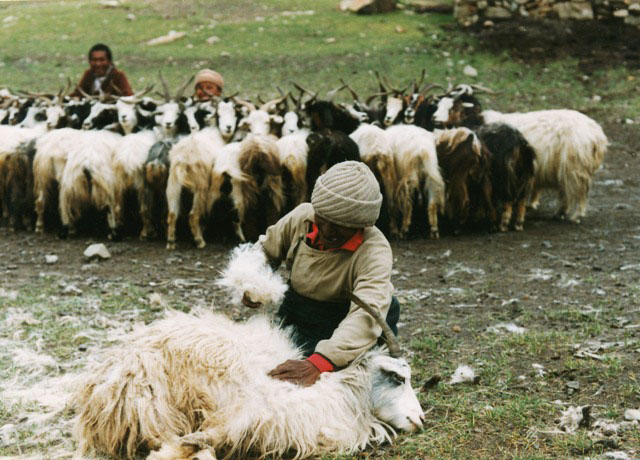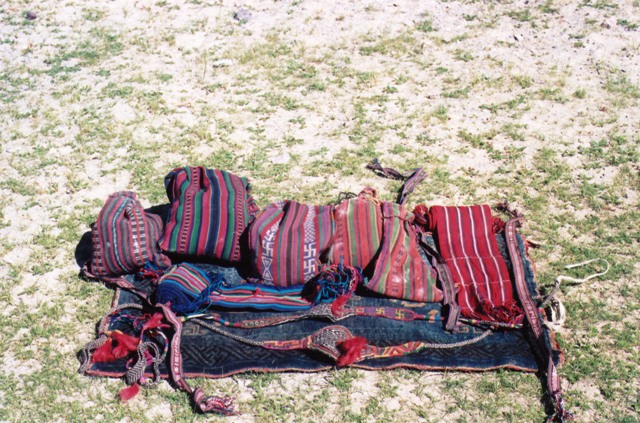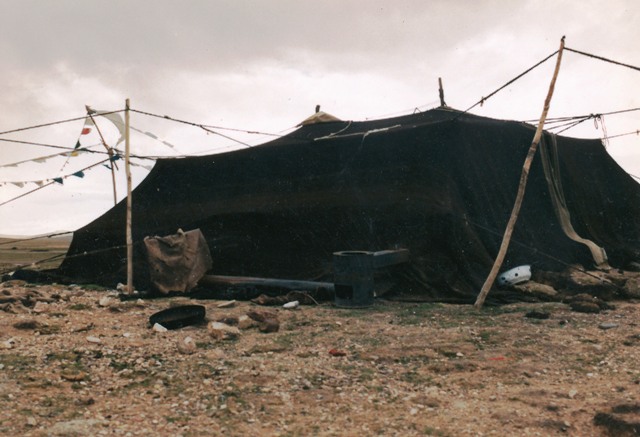
March 2010
John Vincent Bellezza
After four issues in the ethereal realm of the spirit-mediums, this month’s Flight of the Khyung combs the ground for insight into the ordinary lives of drokpas (Tibetan herders). We examine the cultural ecology of a pastoral encampment in Upper Tibet based on a mini study I made in 1994. This newsletter comes from just one daily journal entry.
The setting
Today (September 13) is the 32nd day of the [Divine Dyads I] expedition and a rest day [from walking]. We have trekked more than 340 miles (510 km). I estimate that it is another 70 miles to the Tshochen county seat. We should be there in another four days – sooner if we seek transportation on the Tseri-Tshochen road.
Our campsite is ideal. There is grass, freshwater and it is deserted. There is no tarn at the end of the impounded watercourse. The water simply disappears into the ground. Below this barricaded valley in the Teri Namtsho (bKra-ri gnam-mtsho/Kre-de’i gnam-mtsho) lake basin is a shima (gzhi-ma; a winter pastoral camp), which is now deserted. The livestock and people must be away in the autumn pastures. In addition to Teri Namtsho there is much water in the streams, tarns and springs. Water seems to appear and disappear in the various basins almost by magic. Underlying these basins must be a vast aquifer, much of it in the form of permafrost. Tibetan mythology speaks of hidden interconnections between the Changthang lakes. Is it possible that a hydrological connection exists between, say, Dangra Yumtsho and Teri Namtsho?
From our experience there have been fewer signs of wildlife in the vicinity of Teri Namtsho than at Dangra Yumtsho. Dotriling (Do Khri-gling), an intriguing 8 km-long cape, is visible from our camp. I hope to learn more about its history [author’s note: that would have to wait for another four years]. There is another long cape in the middle of the north side of Teri Namtsho. We hope to round it tomorrow. Teri Namtsho is the fourth major lake of the trek and the third that we are hiking the length of. It is a maximum of 40 miles (70 km) long and averages 15 miles (25 km) in width. It is 200 feet (60 m) higher than Dangra Yumtsho. Teri Namtsho’s shores are exclusively used for pastoral purposes. To the south of the lake basin high peaks pop out of the skyline, part of an intricately knotted Trans-Himalayan range. We are now positioned at 31° N. latitude, directly north of the Shisha Pangma massif. We are low on supplies but will manage a rest day despite our paltry stocks.
[In my journal] I proclaimed Ombu the most remote agrarian territory in Tibet but it depends on a matter of definition. It could be countered that any of the four agricultural pockets (Purang, Gar, Guge and Ruthok) of Ngari is the most remote agrarian territory in Tibet. Since departing Nyima County we have left Naktshang and entered the Chokchu (Phyogs-bcu) region of the Changthang. Chokchu generally corresponds with the limits of Tshochen County. I am on the lookout for regional variations in costumes and material culture. I also want to discern changes in dialects and other features of abstract culture. It seems to me that many regional variations have been effaced by modern political changes. Much of the traditional jewelry was confiscated or sold off. Thokchaks (copper-alloy talismans) and other possible distinguishing features have met the same fate.

Plucking cashmere from a Changthang goat
Weaving sashes
Weaving remains one of the best distinguishing features, in particular sashes. Every region of the Changthang has its own unique designs. The traditional material for sashes is homespun wool but cotton and acrylic are also used these days. In Hor I saw monochrome sashes. In Nakchu there are yellow and red sashes with horizontal stripes. In Damshung there are red sashes with two white pinstripes running the entire length. In Namru there are finely woven sashes of red, blue, white and pink. In Naktshang there are rainbow-colored sashes.
An excellent project would be to collect samples of all styles of sashes woven in Tibet along with weaving lore and technical information. I am eager to refresh my memory and look at the sashes of Chokchu again. On the Changthang sashes are used ubiquitously to tie the national dress, the chuba or lokpa. Men and woman both have them though women’s sashes tend to be narrower. Sashes double up for many other uses: to secure carry-bundles and even to strap a baby on a mother’s back. The art and craft of weaving sashes is very much alive as it is such a functional item [author’s note: this is not nearly as true today, 16 years later]. Alas, I cannot say the same for the beautifully woven boot ties. They are gradually disappearing as factory-made versions become more popular.

Changthang weavings including panniers, sashes, boot ties and slings
Surveying the little things
Breakfast passed and I caught up on small jobs like sealing film canisters. After lunch I ventured out to survey my environs. As I mentioned, the valley we are camped in is impounded. A sandy rampart approximately 10 m tall on the north inner side and roughly 50 m tall on the south outer side seals it off from the Teri Namtsho basin. The valley’s drainage, already reduced in volume, debouches into a sandy basin in front of the rampart. There is more standing water in front of the mouth of the watercourse than yesterday. I suppose at anytime it could vanish into the sands. We are camped above the outlet on a grassy flat. Further up the entire floor of this narrow valley is covered in a bog. This bog is hundreds of meters long, but I don’t really know because up valley it falls out of view.
At the lower edge of the bog, on sandy flat on the right or west side of the valley there is a small, vacated drokpa camp. My guess is that it is a late fall-early winter camp satellite camp. I shouldn’t really call it vacated because I discovered an adult cat living in a recess in a dung pile. It seems quite tame and is probably living on local game and waiting for its owners to return. I passed an engaging afternoon surveying the settlement. Although it is small in scope, it encompasses the spectrum of drokpa life. The good thing about surveying a small settlement is that its essential elements can be readily discerned. They are the same in the larger permanent settlements as well.
The spatial organization of a drokpa encampment
There are five components or landmarks in a drokpa settlement. They are the three fundamental architectural components (shrines, tent foundations and corrals), the dung heaps, and the ash pit and other more diffuse signs of refuse. As this settlement is only a minor one, its three livestock pens are not well developed in terms of the height of the walls, the care taken in construction and the thickness of the layers of dung on the ground.
The settlement under consideration is laid out in an orderly fashion. The tent foundations (nangra) are integrated into the terrain as smooth contours. Adjacent to the tent foundations are the dung heaps including a pile of goat and sheep droppings and a mound of packed yak dung [all of which are used as fuel].
Occupying the highest ground of the settlement is a mani wall, constructed with salvaged mani stones. Although the inscribed stones are damaged, they serve as an important religious symbol. A little further afield but ritually interconnected to the encampment are stone cairns (laptse/la-btsas) on a low-lying eastern saddle and on a higher pass to the north. There must also be laptses at the distant head of the valley and other prominent high points like the conical hilltop east of the valley. These laptses are erected as offerings to the yulha, strident protector deities who inhabit the high country. Tibetans believe that when human activities are in consonance with this society of divine beings, good luck and prosperity result.
The symbolism of the drokpa yak hair tent
The rear/east portion of the tent foundations of this settlement that remains nameless to me is built of three layers of stones. Around the choekhang (altar) this wall is set about 60 cm below the surrounding slope. Cosmological elements both non-Buddhist and Buddhist are involved in the design of the tent foundation. The classic layout of a lhakhang (temple) and the tent foundation bear some resemblance. Like Shamanistic cultures of north Asia, the drokpa tent is a microcosm of the universe. The tent fabric symbolizes the firmament, the tent poles are world-supporting mountains and the tent site is a representation of the earth and the natural processes associated with it. The three central stones of the fire ring represent the three cosmological realms: heaven, earth and underworld.
The tent foundation is designed to accommodate a drokpa yak hair tent, which is erected over it with the aid of poles, ropes and stakes. Drokpa tents are normally raised with two inner poles, the kara, one on each side of the fire pit. There are also ancillary poles positioned on four, six or eight sides of the tent outside. The tent is the ephemeral superstructure, the tent foundation the indelible mark of residence on the land. The orientation and design of the tent foundation is an essential emblem of drokpa cultural life. Tent foundations are built in a special way reflecting form, function and religious beliefs.

The drokpa black yak hair tent
Each part of the walls of a tent foundation has specific uses. The entrance to the tent foundation is in the east, the direction of the rising sun. At the entrance to the structure a large stone is planted into the ground. Functioning like the monastic kyilkor (dkyil-’khor) stone, it has a protective, welcoming and heralding function. In the center of foundation is the fire pit composed of three essential stones surrounded by an outer ring of stones. Behind the fire ring, opposite the entrance, is the place for the choekhang. On the southwest side of the foundation wall is a circular stone chamber deeper than the wall itself. This is a key storage place in the tent associated with the water spirits (lu/klu). On the opposite or northeast side of the tent foundation is a shallower stone chamber for fuel storage.
The camp foundations in this settlement do not seem particularly old or well developed. This is keeping with its itinerant nature. In winter camps I have seen tent foundations built as much as 1.8 m into the ground on the west or choekhang side. These winter structures are constructed of large stones (up to 1 m long) that are skillfully fitted together. I wonder if any of them are ancient and still in continuous use [authors note: some viable tent foundations may be several centuries old].
Refuse and recycling
Approximately 90% of the weight and volume of drokpa refuse is organic (the proportion of organic waste to synthetic waste is lower in more important settlements). Actually, not all of what is scattered about the center and periphery of this drokpa settlement can be called refuse. For example, pieces of canvas lying about would make good patching material if the need arose, and drokpas are eminently practical people. A pair of iron shears that are not even rusted could be reused and lengths of cordage and wool recycled.
Drokpa refuse can be divided into three categories: 1) dead-end products, 2) recyclable materials, and 3) ritualized objects. In this camp in the third category are two cupped pieces of skin with fur on them. One is of yak and the other is of goat. They are clean, unblemished and deliberately shaped. My guess is that the person who worked these animal skins left these well-formed tidbits as an offering to the soul of the animals and/or to the deities that watch over them. Other pieces of skin in the encampment were in varying stages of decomposition, not the kind of things you would want to pick up.
The variety of refuse in this camp points to a society with a fairly sophisticated array of materials at its disposal. Surveying the refuse, I’ll divide its distribution into three areas: 1) lower area (around watercourse issuing from the bog), 2) middle area (within the settlement), and 3) inner area (inside the tent foundations).
In the lower area there were:
Scattered pieces of dung
Yak wool, sheep wool and various kinds of hair
Hoofs with fur and forelock attached
Bits of bone from tarsi to crania in varying states of decomposition
Goat and sheep horns (but no yak horns)
Soles and the uppers of canvas footwear (but no traditional footwear)
Fragments of bridles and textile horse tackle both woven and braided
Leather and fur scraps
Segments of cordage (made of yak hair, goat hair, a combination goat and yak hair, and sheep wool; in thicknesses ranging from 6 mm to 20 mm in diameter; and made using various spinning and braiding techniques)
Cotton and wool threads
Plastic wrapping and strapping
Scraps of woollen and cotton cloth
In the middle area there were many of the same types of refuse as in the lower area. In addition to these there were:
Discarded wool panniers and wool sacks
Tea wrappings
Brush for kindling
Metal screen
Wool strapping and leather cord
Wooden planks and sticks
Glass shards
Wire, a piece of minor machinery and a piece of an electronic device (probably an old radio)
A remnant of a sheep hide coat
Scraps of knitwear and pants
Plastic racks
Old felt hat
Accounts paper
Iron pan, aluminum pan and butter tin
Batteries
Shears
A variety of paper and plastic commercial wrappings
Matchboxes
Inside the tent foundations themselves is much of what occurs in the other two areas of the encampment. Additionally there were:
Fragments of ceramics
An old wooden strip used in a backstrap loom
An old cloth strip from a backstrap loom (it may originally have been a woman’s sash but as its ends were tied together, it was last used for some other purpose)
Aluminum foil
Crow feathers (may not be related to the anthropogenic depositions)
Some of the most interesting pieces of drokpa textiles I have found, especially in terms of age, have been castaways. I remember that in the village of Pooh in Kinnaur the only example of Tibetan boots (lham) I could find were in the village dump happily rotting away.
Still much to learn
Now I will describe my most fascinating discovery of the day. On the east side of the valley up from the encampment I came across two offering structures. These are models of the camp foundations constructed for supernatural inhabitation. One is a little more than 1 m in diameter, the other specimen nearly 2 m in diameter. They are built of the same violet and blue gray flaked stone as the actual camp foundations. In the middle of each are the stones of an imaginary hearth. The west wall is more heavily built just like the real tent foundations. In front of it a pile of white quartz represents the choekhang. Other stones approximated the chambers in the foundation, and a larger kyilkhor stone is set in the east at the entrance. My hunch is that these structures were built as offerings to the water spirits in order to bring rain. [Author’s note: I still do not know the precise function of these miniature tent foundations. In some encampments children make replicas of tents and corrals while playing, but these are of a different character].